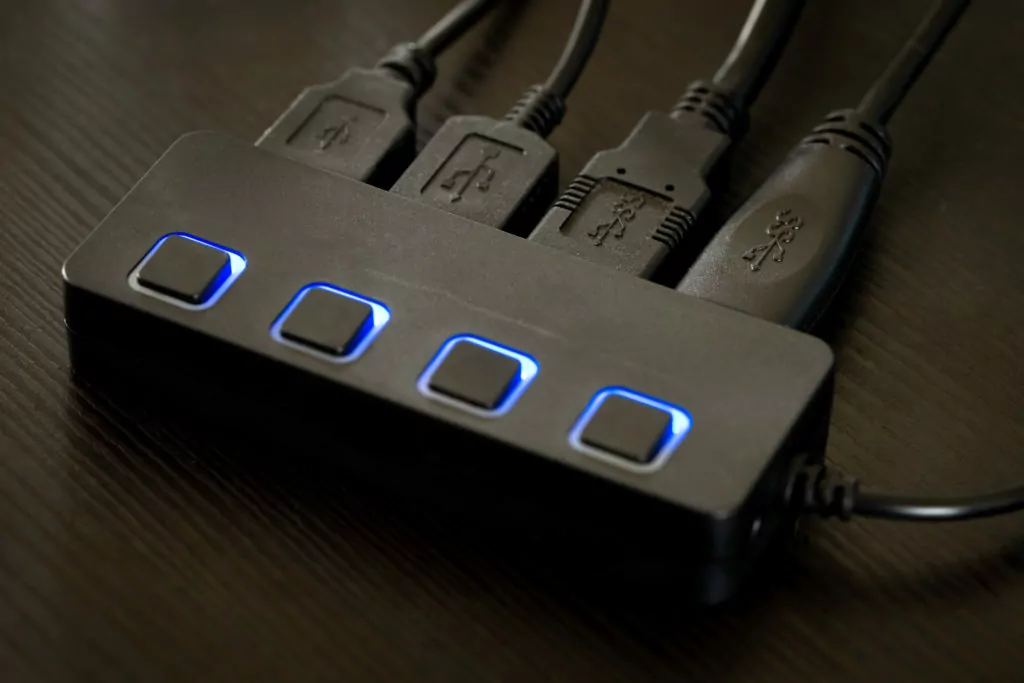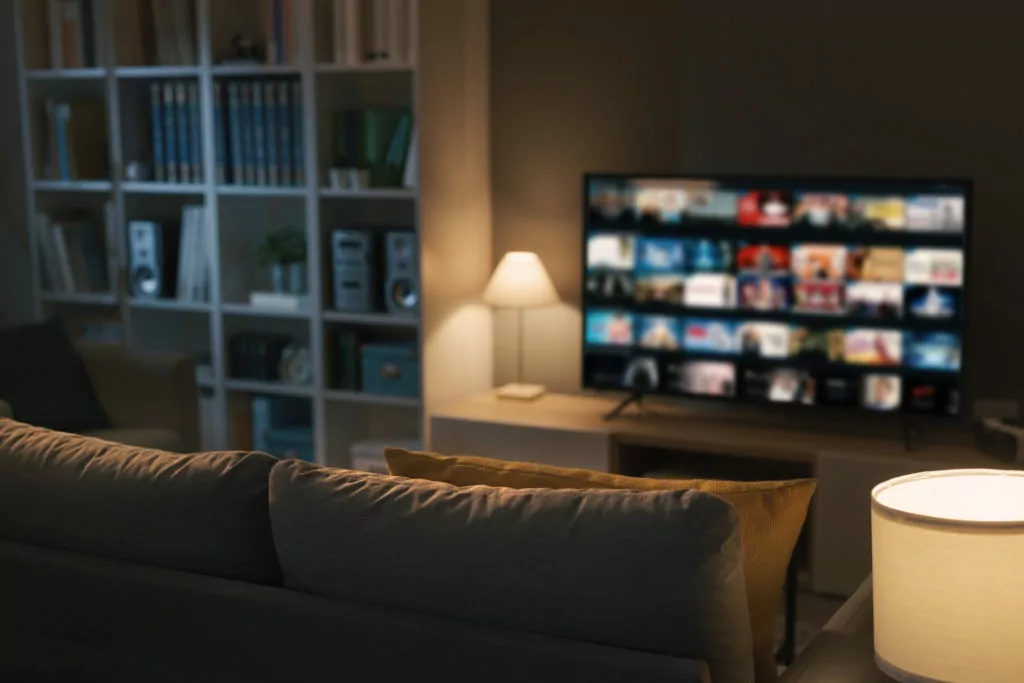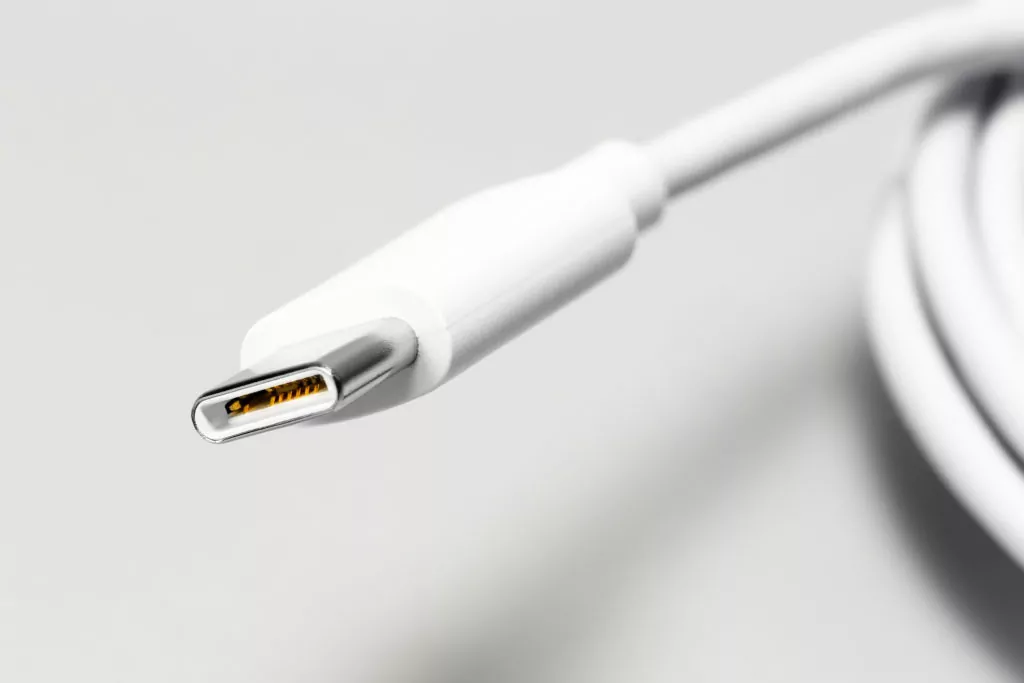Here’s the purpose of USB ports on monitors:
Primarily, these ports act as a built-in USB hub in your monitor.
They allow you to connect additional peripherals, charge devices, connect media for playback and make it easier to set up your computer and workspace.
USB-C ports on a monitor offer even more functions.
If you want to learn all about the purpose of USB ports on monitors, then this article is for you.
Let’s jump right in!
- Data Scientist Monitors: One Big and/or Two Small Monitors?
- Monitor Light Blinking: How to Fix?
- 120 Hz vs. 144 Hz Monitors: Difference?
- All-in-One Computer as Monitor: How To?
- Computer Screen Colors: Easiest on the Eyes?

What Is a USB Hub and Why Does It Matter When It Comes To Monitors With USB Ports?

A USB hub is a device you can get that allows you to expand the capacity of a single USB port on a computer.
The hub plugs into the computer port, and it has additional ports that can be used to attach more USB devices.
It’s a lot like a power strip for USB, but it can do more than just provide electricity.
On a monitor, the hub is built into the device.
There is a dedicated USB port that connects the monitor to the computer.
On the monitor, that port will be labeled, and it doesn’t have the same shape as traditional USB slots.
Instead, this port is square with a notch, and it uses a special cable that creates a passthrough connection to the port on the computer.
When you connect this, the traditional USB ports on the monitor are now active as part of the hub.
You can attach any USB device to the monitor, and it will be able to directly communicate with the computer.
As an example, you can plug your mouse and keyboard into the monitor, and you can use them normally to operate the computer.
Doing this makes it a lot easier to manage cables and organize your workstation.
The hub feature on the monitor also helps with capacity.
The total number of working USB ports you have available is increased by the ports on the monitor.
Plenty of monitors also allow you to connect USB 3.0 (or higher) via the hub.
These connections charge devices faster and allow for faster data rates.
So, if your computer has limited USB 3 slots, the hub on the monitor can compensate and give you more access.
What Is the Easiest Color on the Eye on a Monitor?

Ever wondered what’s the easiest color on the eye on a computer screen?
Then you’re in the right place.
Colors in the middle of the visible spectrum are easy on the eyes.
Examples are red, orange, and yellow.
Blue is the most difficult color to look at.
Blue light is a primary color that tends to flicker more frequently than other primary colors such as oranges or reds, and its wavelengths reach farther into the eye.
Learn all about the easiest color on your eyes on a monitor here.
Can the Monitor Ports Charge Devices?

USB ports on a hub do pass power through the ports.
That means you can charge USB devices by plugging them into your monitor.
What’s more, is that your monitor has its own power supply.
So, even if you don’t connect the monitor to the computer, you can still get power from the USB ports on the monitor.
This is a great way to use your monitor as a charging station if you don’t need the other resources available from the USB hub.
What if the Monitor Is Also a TV?

There are a lot of TVs that double as monitors, and plenty of people use them in this way.
When that is the case, the functions of the USB ports on the monitor are considerably different from that of a built-in USB hub.
For a TV, USB ports are primarily there to allow for additional memory storage.
Some are designed to work with external hard drives.
Others are intended more for flash drive or thumb drive usage.
In theory, there is no difference between these ports and how you use them, but the physical placement on the TV can make it easier to fit some devices when compared to others.
The point of attaching external storage devices to a TV is that your TV can play audio and video files on those devices.
It is important to format everything correctly, but assuming you do, you can store movies, shows, and anything else you want on the attached drives.
Your TV can play them as you see fit.
It’s important to understand that if you have these ports on a TV that you use as a monitor, they do not provide connectivity to the computer.
You can get power from these ports, but you cannot plug in a keyboard to this port and use it on your computer.
Additionally, the media accessed through this port is processed by the TV itself, not the computer.
So, if you want to watch something on the TV/monitor from a flash drive, you won’t be able to do it while the TV is in monitor mode.
You will need to change the input, and then you can watch whatever is on the drive.
Conversely, you could plug that drive into a USB port on the computer and play it that way without changing the input on the monitor.
What About USB-C Ports on Monitors?

So far, we have only covered traditional USB ports.
USB-C is the most modern version of USB.
These ports are a different shape from the rectangular USB slots we all recognize, and they provide considerably more functionality than older USB connections.
For anyone unfamiliar, USB-C is the connection used on most non-Apple smartphones.
It can charge them and allow them to connect to external devices, media, and computers.
Many modern monitors have USB-C ports on them, and they provide a number of options for users.
For starters, the USB-C ports here can function like a hub that works the same way as what was already discussed.
You can attach USB-C peripherals this way, and they will be able to directly communicate with the computer.
You can also charge USB-C devices (like a phone), and they will charge faster than if you use a USB 3 (or older) port.
Overall, USB-C ports allow you to communicate with the computer, add data storage, play videos, and more.
There’s an additional feature of USB-C that makes it even more interesting as a port choice for a monitor.
You can daisy-chain additional monitors using these ports.
This is to say that you can plug an additional monitor into your current monitor using that USB-C port.
When you do, you add a fully functional display to your setup.
In most cases, the second monitor doesn’t even need a power cable.
It draws enough juice from that USB-C port.
You can continue the daisy chain beyond a second monitor.
This will depend on the design of the monitor.
For larger monitors that work at higher qualities, the power needed to function is higher than average.
If power needs are not constraining, you can daisy-chain up to three additional monitors to your original.
That means you can have four working displays on one setup using USB-C daisy chains.
Keep in mind that each added monitor will need an open USB-C slot to continue the chain.
What Does a Blinking Monitor Light Mean and How to Fix It?

Don’t be surprised if your monitor light starts blinking.
Here’s what a blinking monitor light means and how to fix it.
Fixing a blinking monitor light can involve a lot of different possibilities and steps.
The goal is to isolate the root of the problem and then make your repairs based on that isolation.
In order to do that, you can test the monitor, cables, and any adapters with a computer you know is working to try to root it out.
Learn all about the meaning of a blinking monitor light and how to fix it here.

